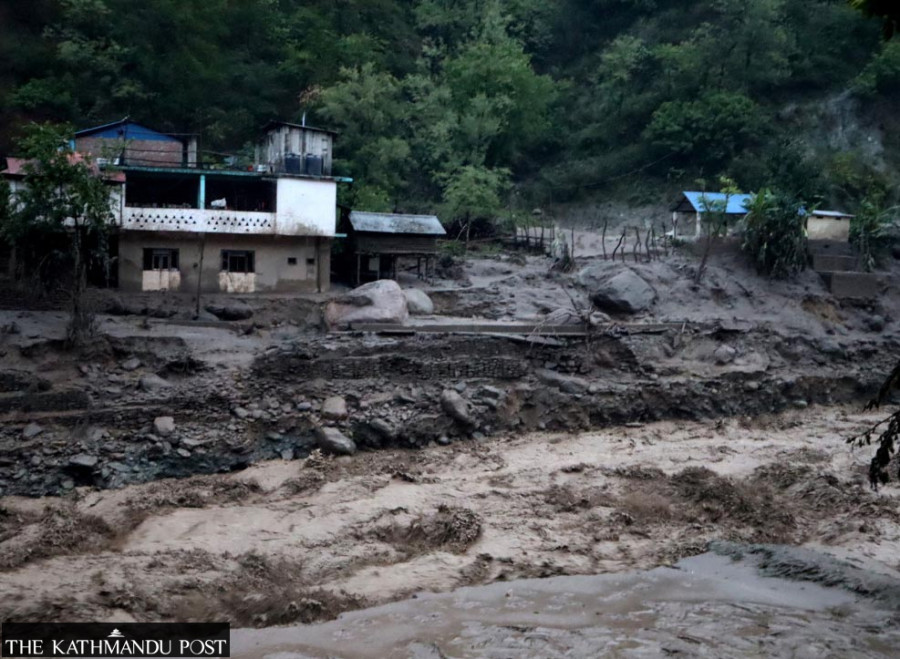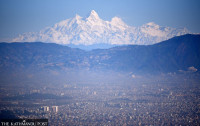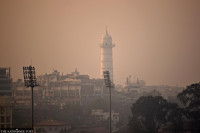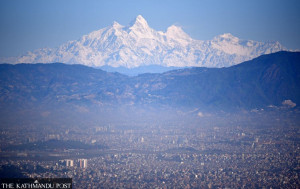Climate & Environment
Rain-induced disasters in the east and heat waves in west
Erratic weather patterns have become normal of late and the country is unprepared to cope with them.
Arjun Poudel
Nepal has of late been witnessing two contrasting weather patterns. While heavy rainfall has caused deaths and devastation in the eastern part of the country, scorching heat has made life difficult in the mid-western districts.
According to the National Disaster Risk Reduction and Management Authority, heavy rainfall has caused destruction in several districts of Koshi Province—especially Taplejung, Panchthar, Sankhuwasabha and Terhathum—where at least five persons died and 28 others have reportedly been missing following floods and landslides. Widespread damage to physical infrastructure—roads, bridges, and a hydel project—have been reported from the flood and landslide-hit areas.
“Monsoon has only started but we have already started witnessing devastation from floods and landslides,” said Dhruba Bahadur Khadka, spokesperson for the authority. “This could be just a start as there will be more rainfall this monsoon. All agencies concerned have been activated for rescue and relief works.”
In a sharp contrast, people in the western Tarai region have been bearing the onslaught of rising temperatures with little respite. Heat waves that started in the first week of June have continued unabated in several districts of the central and western Tarai.
According to the Meteorological Forecasting Division under the Department of Hydrology and Meteorology, Kapilvastu recorded 44.6 degrees Celsius on Saturday, the highest this year.
On Sunday, Bhairahawa recorded 43.7 degrees Celsius, Nepalgunj 41.5, Dhangadhi 41.2, and Simara 40.3 degrees Celsius, Janakpur 39.8 degrees Celsius, Dipayal 39.2, Birendranagar 39.1 and Ghorahi 39 degrees Celsius.
Monsoon clouds, which entered the country on June 14, are active in the hilly areas of Koshi, Bagmati and Gandaki Province. Met officials say the withdrawal of the effects of cyclone Biparjoy, which made landfall on the western coast of India and also made inroads into the coastal areas of Pakistan, interfered with the monsoon phenomenon. This could go on for up to four days.
“We expect some relief from the scorching heat from Monday in western Nepal as the effects of cyclone Biparjoy have brought clouds there,” said Prativa Manandhar, a meteorologist. “Border areas of Gandaki and Lumbini provinces have been witnessing rainfall caused by the effects of cyclone Biparjoy.”
Climate scientists say incidents of floods, landslides, and inundations are just a start and such extreme events could escalate in the coming days.
Erratic weather events—heavy rainfall in a short span of time in some places, lack of rainfall for months and even during mid-monsoon in other places, continued rainfall for several days and other unusual weather events—have become frequent in Nepal, said Dr Indira Kandel, a senior divisional meteorologist at the Climate Analysis Section under the Department of Hydrology and Meteorology.
“More rainfall within a short span means more incidents of floods and landslides,” she said. “We don’t know how prepared the authorities concerned are, but such incidents could become frequent in the coming days.”
Amid this, experts urge the authorities to start preparing for the worst.
However, if the plight of disaster victims of the past years is anything to go by, it seems that the authorities are not serious about the possible incidents of disasters.
“We have been residing in makeshift shelters for the past three years,” said Rohit Lama, a local from Lidi of Jugal Rural Municipality-2, Sindhupalchowk district. “We have been deprived of grants promised by governments at the federal, provincial and local levels to rebuild our houses.”
At least 39 people died when a landslide struck Lidi village on August 14, 2020 and 239 families were displaced from the village. According to Himal Kumar Shrestha, deputy chairman of the rural municipality, around 200 victims got grants to purchase lands but no one got any grant for house construction.
“Our local unit has not allocated any budget for grants to be provided to the displaced people,” Shrestha said.
Every year, floods and landslides cause huge loss of life and property, but the country is still poorly prepared to deal with disasters.
“It is painful to be living in makeshift shelters for years,” Lama, the landslide survivor from Lidi, said. “We don’t know how long we have to wait for a relief amount to build a house.”




 15.12°C Kathmandu
15.12°C Kathmandu











